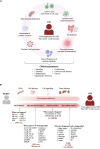Multi-omics in HIV: searching insights to understand immunological non-response in PLHIV
- PMID: 37649488
- PMCID: PMC10465175
- DOI: 10.3389/fimmu.2023.1228795
Multi-omics in HIV: searching insights to understand immunological non-response in PLHIV
Abstract
Antiretroviral therapy (ART) induces persistent suppression of HIV-1 replication and gradual recovery of T-cell counts, and consequently, morbidity and mortality from HIV-related illnesses have been significantly reduced. However, in approximately 30% of people living with HIV (PLHIV) on ART, CD4+ T-cell counts fail to normalize despite ART and complete suppression of HIV viral load, resulting in severe immune dysfunction, which may represent an increased risk of clinical progression to AIDS and non-AIDS events as well as increased mortality. These patients are referred to as "immune inadequate responders", "immunodiscordant responders" or "immune nonresponders (INR)". The molecular mechanisms underlying poor CD4+ T-cell recovery are still unclear. In this sense, the use of omics sciences has shed light on possible factors involved in the activity and metabolic dysregulation of immune cells during the failure of CD4+ T-cell recovery in INR. Moreover, identification of key molecules by omics approaches allows for the proposal of potential biomarkers or therapeutic targets to improve CD4+ T-cell recovery and the quality of life of these patients. Hence, this review aimed to summarize the information obtained through different omics concerning the molecular factors and pathways associated with the INR phenotype to better understand the complexity of this immunological status in HIV infection.
Keywords: PLHIV; genomics; immunological non-response; metabolomics; proteomics; transcriptomics.
Copyright © 2023 Espineira, Flores-Piñas, Chafino, Viladés, Negredo, Fernández-Arroyo, Mallolas, Villar, Moreno, Vidal, Rull and Peraire.
Conflict of interest statement
The authors declare that the research was conducted in the absence of any commercial or financial relationships that could be construed as a potential conflict of interest.
Figures

References
-
- Bono V, Augello M, Tincati C, Marchetti G. Failure of CD4+ T-cell Recovery upon Virally-Effective cART: an Enduring Gap in the Understanding of HIV+ Immunological non-Responders. New Microbiol (2022) 45:155–72. - PubMed
Publication types
MeSH terms
LinkOut - more resources
Full Text Sources
Medical
Research Materials

